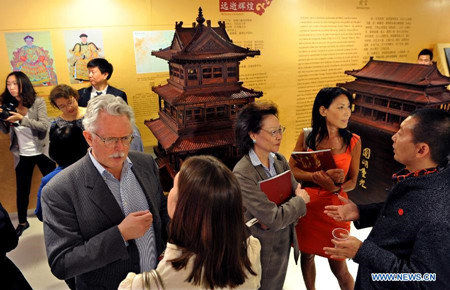
. > TOP STORIES
Cultural diplomacy presents a colorful China
Author : Zhang Junrong Source : Chinese Social Sciences Today 2014-09-26
During his visit to Argentina on July 19, Chinese President Xi Jinping offered a set of Chinese DVDs as state gift to Argentinian Vice President Amado Boudou. Unlike previous traditional state gifts from China such as pandas, porcelain or tea, Xi gave DVDs of the director Teng Huatao’s film Love Is Not Blind (2011) and Zhao Baogang’s acclaimed TV series Beijing Youth and To Elderly With Love.

Visitors attend an exhibition on the Old Summer Palace, also known as Yuanmingyuan, in Paris on September 9. Photo: Xinhua
The gifts were reportedly chosen to reflect modern China and the lives of its youth.
Scholars held that President Xi’s move reflected good cultural diplomacy, which they hailed as conducive to presenting a colorful China.
“Culture was a means in the past, but now it has become a purpose,” said Zhao Kejin, an associate professor at the Institute of International Studies at Tsinghua University and senior research fellow at the Charhar Institute.
The incorporation of popular films and TV series into the list of state gifts not only demonstrates that China’s diplomatic policy of culture has changed the role of culture from a medium to an entity, but also marked a natural outcome of socioeconomic development, added Zhao.
“Apart from making our country known to the world, the aim of cultural diplomacy is to exhibit a colorful, civilized and pleasant China,” he claimed.
According to Zhang Qingmin, a professor at the School of International Studies at Peking University, “raw materials” used for cultural diplomacy purposes are mostly quintessential elements of traditional Chinese culture that propagates Chinese values.
Adding elements of modern popular culture will not change the essence of cultural diplomacy but instead mirror the direction and trend of China’s cultural diplomacy, said Zhang.
Zhao agreed with Zhang, saying that the integration of cultural products such as music, art and dance into diplomacy as a way of introducing China to the international community in understandable “languages” can contribute to the building of bilateral trust.
“The ultimate goal of cultural diplomacy is to ‘beautify’ the profile of China in the global society. Rich traditional resources are indispensible, but new culture that keeps abreast with the times is also necessary,” Zhang said.
“The development of Chinese films and art embodies new developments of Chinese culture and represents the real potential of the country’s culture in going global,” he added.
In recent years, China’s cultural diplomacy has made new advancements as evidenced by the popularity of the TV series A Beautiful Daughter-in-law Era in East Africa, widespread installments of the Confucius Institute and worldwide craze for learning Chinese.
However, this process is fraught with misunderstandings and negative voices about specific ways of carrying out cultural diplomacy.
From Zhao’s standpoint, this doesn’t mean that there is anything wrong with cultural diplomacy per se, but there is a need to adjust the way of practice.
“Cultural diplomacy is by no means one-sided publicity and promotion. It instead entails two-way communication, so attention should be paid to improving the way of practice,” he said.
Li Zhi, a professor at the Center for International Communication Studies at the Communication University of China, noted that cultural diplomacy implies cultural communication in addition to its relevance to international power relations and ideology.
Research of cultural diplomacy can therefore also be conducted from the perspective of cross-cultural communication to analyze the process and strategies of cross-cultural exchanges, Li said.
“Cultural diplomacy aims to spread national symbols and information, cultural trade comprises profit-oriented commercial activities and cultural communication is a social behavior, such as exchanges between locals and tourists. Nongovernmental cultural trade and communication can well complement cultural diplomacy,” said Zhao.
Li said that cultural diplomacy, as a carrier of international competition of symbol and information, has become the third-most important diplomatic form following political and economic diplomacy, playing an irreplaceably flexible role.
Zhang asserted that no matter how the situation changes, China’s thinking of cultural diplomacy remains unchanged with consistent content.
“Based upon the culture of Chinese people, the country’s cultural diplomacy channels the subtle influence of culture to serve and supplement the overall diplomatic strategy,” he added.
The Chinese version appeared in Chinese Social Sciences Today, No. 645, September 12, 2014.
The Chinese link: http://sscp.cssn.cn/xkpd/xszx/gn/201409/t20140912_1324800.html
Translated by Chen Mirong
Revised by Tom Fearon
Ye Shengtao made Chinese fairy tales from a wilderness
Ye Shengtao (1894–1988) created the first collection of fairy tales in the history of Chinese children’s literature...
-
How northern ethnicities integrated into Chinese nation
2023-09-18
-
Mogao caves
2023-09-12
-
Mogao Grottoes as ‘a place of pilgrimage’
2023-09-12
-
Time-honored architectural traditions in China
2023-08-29
-
Disentangling the civilizational evolution of China
2023-08-28
-
AI ethics in science fiction
2023-08-23













 2011-2013 by www.cssn.cn. All Rights Reserved
2011-2013 by www.cssn.cn. All Rights Reserved